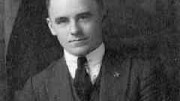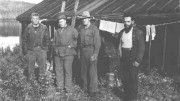The timing of my first column in a new, intermittent series examining mining personalities and major discoveries is auspicious for several reasons. From the Ground Up, the authorized biography of Viola MacMillan (1903-1993), will be published this summer. Its release is bound to rekindle memories of the Windfall scandal of the 1960s, and perhaps even trigger discussion about junior mining and the many challenges it faces today.
The Bre-X saga staggers on in the courts, gold prices remain low, and some companies have been left homeless by recent restructuring of capital markets. Furthermore, the Toronto Stock Exchange is proposing to acquire the Canadian Venture Exchange, which adds more uncertainty as to how juniors will fare in the process.
Further diminishment of junior mining would be a tragedy for Canada, which is a world leader in exploration methodology and mining technology. The successful Prospectors & Developers Association of Canada (PDAC) conventions testify to these achievements. Because of her role in building the association, Viola MacMillan, in many ways, epitomized junior mining in Canada.
I first met Viola in the late 1950s, at an Open House to kick off the PDAC’s annual convention. She was president at the time, but it wasn’t until years later, when I became PDAC president, that I came to know and appreciate her.
Viola was my head-table companion at the PDAC’s 1982 banquet, which celebrated the 50th anniversary of our association. It was her first official appearance since the Windfall affair, when, in 1967, she was convicted and sentenced for wash trading by County Court Judge G.H.F. Moore. (The term “wash trading” is used to describe stock actions in which ownership of the stock does not change hands, but creates the impression of activity.) She was later pardoned, though, in my opinion, “exonerated” would be a more appropriate term.
There are many superlatives used to describe Viola, but for this particular event, I will use the word “strong.” She was not one to display her emotions, but when she was introduced to a packed house in the Canadian Room at the Royal York Hotel, the crowd spontaneously jumped to its feet with cheers and clapping. She was overcome by the response and wept. Later, she told me how terrified she was that the industry would not welcome her back. She also was understandably fearful of how the media would react.
Let’s step back in time to the Texas Gulf discovery in the Timmins, Ont., area during the early 1960s. I was working in the Toronto office of Phelps Dodge, and vividly recall the excitement of those times. The results of the initial diamond drill holes were spectacular and significant in relation to a strong, coincident electromagnetic anomaly — all of which pointed to a major deposit.
Times were good, the markets were bullish, and juniors were off to college one day, and graduating with orebodies the next. At the time, the name Viola MacMillan was synonymous with the PDAC, and with successful mining ventures. By this point, she had sold off her lucrative mines. Although recovering from a heart attack, she couldn’t resist jumping into the rush with both feet, though field operations were under the direction of a prominent consultant and company staff.
As it turned out, Windfall Oils & Mines ended up as the feature attraction of the whole extravaganza. It seemed that everyone, including the Toronto Stock Exchange, was caught up in the hype that Windfall had made a major discovery. Later, when the opposite proved true, the government of Ontario was obliged to take action. Viola carried a high profile (in part because she was a woman, and an extraordinary one at that) and became the focus of a Royal Commission investigation.
Though acquitted of fraud charges related to the Windfall fiasco, Viola was convicted of wash trading in Consolidated Golden Arrow Mines (which later became Canadian Arrow Mines, owner of a open-pit gold producer near Matheson). At the time, wash trading was a commonplace, overlooked practice. The courts would have been jammed had similar charges been laid against others.
From this event forward, I saw Viola frequently and got to know her well, mostly because of my long acquaintance with renowned prospector Franc Joubin (1911-1997), who was her close friend. Franc told me that after Viola’s pardon (complete with apologies), he and she re-examined all of the court proceedings. From my own research, I believe Viola was a scapegoat. The investigations were thorough, and the court officials, to a large extent, were credible. They should have been left to their devices, but the Ontario government (including ministers) intervened.
The Windfall affair led to tighter restrictions for junior companies, many of which moved to Vancouver. Later, in the early 1980s, the Ontario government initiated and funded an independent study of junior companies. It concluded that the net results of junior mining were positive, that investors, in general, were well-aware of the risks and rewards and wanted to keep buying and selling junior mining stocks.
In 1991, at the age of 88, Viola became the first woman ever inducted into the Canadian Mining Hall of Fame. The citation noted her two careers, first as a mine-finder and mine-financier, and then as the driving force in transforming a regional association of prospectors into “an internationally recognized association of professionals involved in all aspects of mineral exploration in Canada.”
Her contributions were many, ranging from the Hallnor and Canadian Arrow gold mines and the Kam-Kotia base metal mine in Ontario, the silver-lead deposits of ViolaMac in British Columbia, and the Lake Cinch uranium deposits of northern Saskatchewan.
Viola MacMillan’s greatest contribution to the mining industry was her predominant role in building the PDAC. She was elected president just before the Second World War and remained in office until 1966. During the war, she was heavily involved in the Wartime Metals Control Commission. After the war, she persuaded the government to adopt the Emergency Gold Measures Act, which saved the industry during the 1950s and ’60s.
Her contributions extended beyond the mining world. She raised funds for the Women’s College Hospital for more than 20 years, and was the driving force behind the Viola MacMillan National Mineral Gallery in Ottawa, one of the best such galleries in the world. She received the Order of Canada and was listed, in a July 1998 issue of Maclean’s magazine, as one of the 100 most important Canadians in history.
— The author, a retired mining engineer, resides in Barrie, Ont.






Be the first to comment on "Odds ‘n’ Sods: Remembering the ‘Queen Bee’ Viola MacMillan"